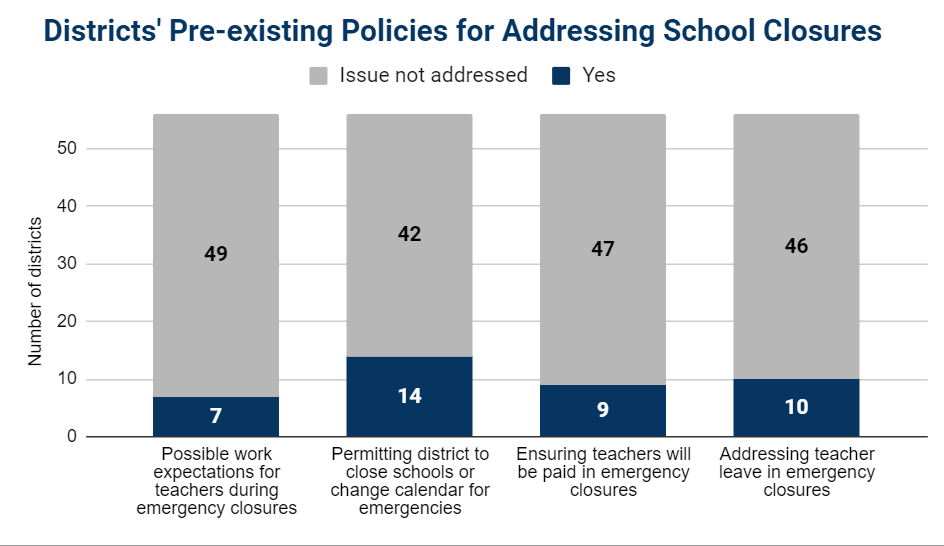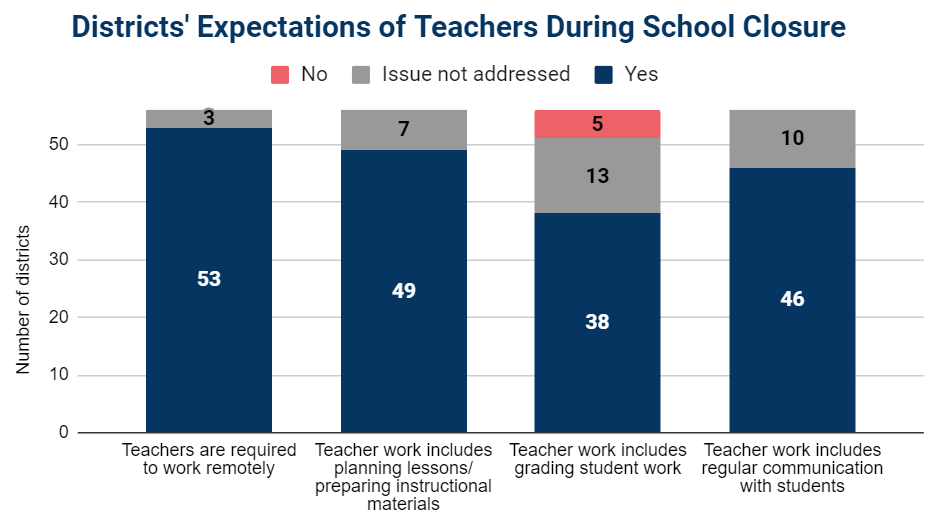How are school districts adapting teacher work policies for emergency closures?
Understandably, the sudden closure of schools has been both immeasurably difficult and confusing for students and adults alike. The first priority for most school districts when the pandemic hit was ensuring the safety and nutrition of students, but the focus has increasingly turned to how to keep students learning when physical school buildings are closed—and that requires forging teacher policies to address issues about which no one had ever given much thought.
Since 2007, the National Council on Teacher Quality (NCTQ) has been collecting, analyzing, and comparing teacher collective bargaining agreements and board policies in large school districts. When this crisis hit, we asked what, if anything, districts had spelled out in their existing policies relevant to teacher work, pay, and leave in situations of emergency school closures. Then we started collecting the new policies districts are adopting for teachers.
What existing policies did districts have in place to deal with emergency closures?
Our initial analysis of 56 large districts across the country found that most districts did not have pre-existing policies in place to deal with this crisis. A minority had any policies that addressed teacher work expectations, pay, or leave in the case of a non-weather-related emergency school closure, let alone provisions for remote learning.

Of the 45 districts we examined that collectively bargain (the remaining 11 are in states which do not permit collective bargaining, instead leaving the decisions up to state legislators and school boards), Orange County (FL) was the only one where the collective bargaining agreement required the district and union to bargain new policies for teachers for the emergency closure. However, many teachers’ unions and associations immediately began working to address the emergency situation.
Are districts working with their unions on new policies?
Sixteen of the large districts we examined have entered into formal agreements with their teachers unions: Boston, Broward County (FL), Chicago, Duval County (FL), Fresno (CA), Hawaii (which is organized as only one school district), Hillsborough County (FL), Long Beach (CA), Los Angeles, Miami-Dade, Orange County (FL), Pinellas County (FL), Saint Louis, San Diego, San Francisco, and Seattle. Another 11 large districts are working informally with their unions to issue joint communications and guidance to teachers.
Even without negotiations with unions, however, almost all the districts in the sample are working to clarify teacher expectations. Many states are providing guidance, such as California, Illinois, Massachusetts, and New Mexico, but as in many areas of teacher policy, it is up to districts to establish the specifics as it applies to their schools and teachers.
How are districts adapting various teacher policies to the new reality?
We reviewed available agreements with unions, new school board policies, online communications to teachers, and plans for transitioning to distance learning that districts have posted online to ascertain what policies districts are now adopting for teachers during the closures—with or without a formal agreement with a union.
Nearly all have officially communicated that teachers will continue to be paid throughout the closure period, and nearly all are communicating clear work expectations for teachers, such as working from home requires teachers to plan lessons, prepare instructional materials, and communicate regularly with students.
Delivery of online lessons. The Center on Reinventing Public Education (CRPE) has put together and is regularly updating a database of districts' distance learning plans, and those data, as well as teacher surveys and news reporting, indicate that the start of these plans was rather chaotic. Over the past month, however, CRPE data show that an increasing number of districts began providing formal curricula, instruction, and feedback to students.
Grading student work. The issue of whether or not teachers should be grading student work during distance learning is a difficult one due to issues of equity and access. Thirty-eight districts from our sample have specified that teachers of at least some grades and subjects will grade student work, while only five have specified that student work will not be graded. Among the districts issuing grades to students, many are implementing "no penalty" grading, where completed work can only increase a student's grade or only issuing “Pass/Fail” or “Pass/Incomplete” grades.
Leave Policies. Federal action to expand the Family and Medical Leave Act (FMLA) has provided additional security for teachers, but with teachers now working remotely and on varying schedules, districts are faced with needing to clarify regular leave policies. Many districts, such as Los Angeles, Miami-Dade, New York City, and San Diego—have articulated more flexible leave policies, such as not requiring teachers to officially take half-day leaves, not requiring doctor's notes, or appreciating that teacher work hours need to be flexible around the needs of caring for their own children or family. Other districts are providing additional emergency leave to teachers during this time.
Looking ahead. As closures extend through the end of the school year and potentially into the fall, new challenges have arisen for districts, among them hiring, professional development, and teacher evaluations. As of this writing, at least 25 states that have issued waivers or guidance on teacher evaluations for the 2019-20 school year. While most large districts we examined have yet to communicate what they will be doing about teacher evaluations, a few have made decisions to either suspend evaluations or only issue ratings to teachers for whom enough evidence was collected prior to the closure.
NCTQ will continue to monitor districts' policy responses for their teachers, with the hope that we can learn lessons and communicate useful examples to others working to respond to these unprecedented challenges.
This post was guest-authored by Nicole Gerber, Director of Strategic Communications at the National Council on Teacher Quality. The mission of NCTQ is helping to ensure that every child has an effective teacher and that every teacher has the opportunity to be effective. Learn more at www.nctq.org.
AddThis Sharing Buttons

